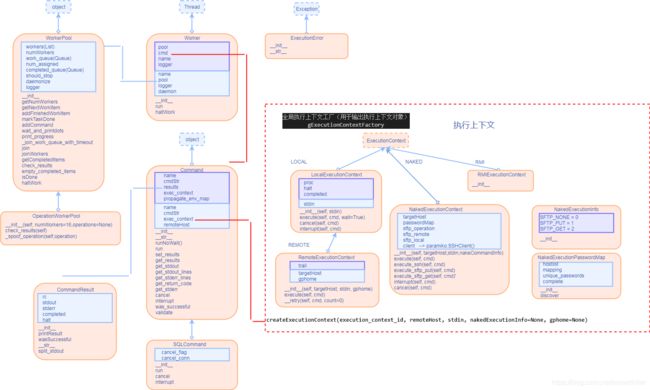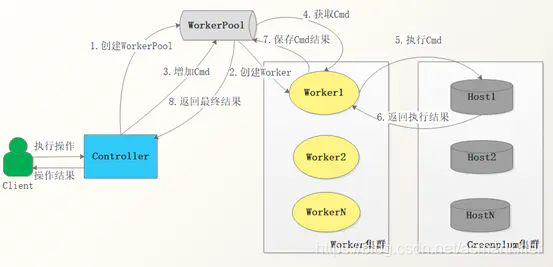Greenplum Python专用库gppylib学习——base.py
base.py依赖的python包(Queue,threading,os,signal,subprocess/subprocess32,sys,time,warnings,paramiko,getpass),依赖的gp包(gplog,gpsubprocess,pygresql)。pygresql导入语句的是from pygresql.pg import DB,主要使用的DB是SQLCommand类,这个类先不用关注。gpsubprocess是对subprocess的封装,可以看到这里使用了两个子进程包gpsubprocess和subprocess。
代码分析
WorkerPool类
先看WorkPool类定义,类实例包含了存放worker实例的列表、存放带执行Command的work_queue队列、存放执行完Command的completed_queue队列。WorkerPool中的worker实例的数量是在构造函数就给定的,初始化后worker实例会一直运行,图中的start就是在构造函数中完成的。Worker实例从work_queue队列中取工作项Command的函数是getNetWorkItem。
def getNextWorkItem(self):
return self.work_queue.get(block=True)
Worker实例处理完成work_queue中所有命令之后,取不到命令或取到的命令是halt_command,或者任务池标志了should_stop之后,使用markTaskDone函数告知WorkPool该任务完成。
def markTaskDone(self):
self.work_queue.task_done()
clsSystemState.py的GpSystemStateProgram类中run函数中有base文件中类的使用示例,简化如下,通过这些示例来学习任务池的使用:
dispatchCount = 0
pool = base.WorkerPool(parallelDegree) #parallelDegree给定worker个数
for hostName, segments in ...:
cmd = ...
hostNameToCmd[hostName] = cmd
pool.addCommand(cmd)
dispatchCount+=1
pool.wait_and_printdots(dispatchCount)
hostNameToResults = {
}
for hostName, cmd in hostNameToCmd.iteritems():
hostNameToResults[hostName] = cmd.decodeResults() #取出结果集
pool.haltWork()
主要流程:通过addCommand函数向队列(work_queue)中添加工作负载(WorkerPool类可以通过构造函数向队列中添加多个命令(列表形式),或者通过addCommand函数添加单个命令)。针对work_queue队列由三种join的方法,代码如下。hostNameCmd是一个字典,键为hostName,值为cmd。通过cmd.decodeResults函数取出结果集。
def join(self):
self.work_queue.join()
return True
def _join_work_queue_with_timeout(self, timeout):
"""
Queue.join() unfortunately doesn't take a timeout (see
https://bugs.python.org/issue9634). Fake it here, with a solution
inspired by notes on that bug report.
XXX This solution uses undocumented Queue internals (though they are not
underscore-prefixed...).
"""
done_condition = self.work_queue.all_tasks_done
done_condition.acquire()
try:
while self.work_queue.unfinished_tasks:
if (timeout <= 0):
# Timed out.
return
start_time = time.time()
done_condition.wait(timeout)
timeout -= (time.time() - start_time)
finally:
done_condition.release()
def wait_and_printdots(self, command_count, quiet=True):
while self.completed_queue.qsize() < command_count:
time.sleep(1)
if not quiet:
sys.stdout.write(".")
sys.stdout.flush()
if not quiet:
print " "
self.join()
属性 描述
Queue(maxsize=0) 创建一个先入先出队列。如果给定最大值,则在队列没有空间时阻塞;否则,为无限队列
LifoQueue(maxsize=0) 创建一个后入先出队列。如果给定最大值,则在队列没有空间时阻塞;否则,为无限队列
PriorityQueue(maxsize=0) 创建一个优先级队列。如果给定最大值,则在队列没有空间时阻塞,否则,为无限队列
Queue/queue异常
属性 描述
Empty
当对孔队列调用get*()方法时抛出异常
Full 当对已满的队列调用put*()方法时抛出异常
Worker类
worker类继承自threading模块中的Thread类,run函数先使用getNextWorkItem函数取得command,总共有四种情况:任务池中没有command,该Worker示例需要向任务池标记任务完成;如果取得的命令是pool.halt_command,该Worker示例需要向任务池标记任务完成;如果任务池标记了should_stop,该Worker示例需要向任务池标记任务完成;下面是正常流程,执行命令,并将命令放入任务池完成队列。
class Woker(Thread):
...
def run(self):
while True:
try:
try:
self.cmd = self.pool.getNextWorkItem()
except TypeError:
# misleading exception raised during interpreter shutdown
return
# we must have got a command to run here
if self.cmd is None:
self.logger.debug("[%s] got a None cmd" % self.name)
self.pool.markTaskDone()
elif self.cmd is self.pool.halt_command:
self.logger.debug("[%s] got a halt cmd" % self.name)
self.pool.markTaskDone()
self.cmd = None
return
elif self.pool.should_stop:
self.logger.debug("[%s] got cmd and pool is stopped: %s" % (self.name, self.cmd))
self.pool.markTaskDone()
self.cmd = None
else:
self.logger.debug("[%s] got cmd: %s" % (self.name, self.cmd.cmdStr))
self.cmd.run()
self.logger.debug("[%s] finished cmd: %s" % (self.name, self.cmd))
self.pool.addFinishedWorkItem(self.cmd)
self.cmd = None
except Exception, e:
self.logger.exception(e)
if self.cmd:
self.logger.debug("[%s] finished cmd with exception: %s" % (self.name, self.cmd))
self.pool.addFinishedWorkItem(self.cmd)
self.cmd = None
def haltWork(self):
self.logger.debug("[%s] haltWork" % self.name)
c = self.cmd
if c is not None and isinstance(c, Command):
c.interrupt()
c.cancel()
threading模块的Thread类实例化表示一个执行线程的对象,拥有的数据属性name(线程名)、ident(线程的标识符)、daemon(布尔标志,表示这个线程是否是守护线程),方法如下:
Thread对象方法描述
_ini_(group=None, target=None, name=None, args=(), kwargs={}, verbose=None, daemon=None) 实例化一个线程对象,需要有一个可调用的target,以及其参数args或kwargs。还可以传递name或group参数,不过后者还未实现。此外,verbose标志也是可以接受的。而daemon的值将会设定thread.daemon属性/标志
| 成员 | 描述 |
|---|---|
| start() | 开始执行该线程 |
| run() | 定义线程功能的方法(通常在子类中被应用开发者重写) |
| join(timeout=None) | 直至启动的线程终止之前一直挂起;除非给出timeout(秒),否则会一直阻塞 |
| getName() | 返回线程名 |
| setName(name) | 设定线程名 |
| isAlivel/is_alive() | 布尔标志,表示这个线程是否还存活 |
| isDaemon() | 如果是守护线程,则返回True;否则,返回False |
| setDaemon(daemonic) | 把线程的守护标志设定为布尔值daemonic(必须在线程start()之前调用) |
使用Thread类可以有很多方法创建线程,这里介绍三种方法:1. 创建Thread的实例,传给它一个函数;2. 创建Thread的实例,传给它一个可调用的类实例;3.派生Thread的子类,并创建子类的实例。
Command类
Command类有两个执行函数runNoWait和run函数,runNoWait函数通过调用exec_context.execute(self,wait=False)函数执行命令,并返回proc;run函数直接调用exec_context.execute(self)函数。
def runNoWait(self):
faultPoint = os.getenv('GP_COMMAND_FAULT_POINT')
if not faultPoint or (self.name and not self.name.startswith(faultPoint)):
self.exec_context.execute(self, wait=False)
return self.exec_context.proc
def run(self, validateAfter=False):
faultPoint = os.getenv('GP_COMMAND_FAULT_POINT')
if not faultPoint or (self.name and not self.name.startswith(faultPoint)):
self.exec_context.execute(self)
else:
# simulate error
self.results = CommandResult(1, 'Fault Injection', 'Fault Injection', False, True)
if validateAfter:
self.validate()
pass
ExecutionContext类
以RemoteExecutionContext执行上下文类为例,参数是以以下方法处理的
keys = sorted(cmd.propagate_env_map.keys(), reverse=True) for k in keys: cmd.cmdStr = "%s=%s && %s" % (k, cmd.propagate_env_map[k], cmd.cmdStr),将参数序列化到cmdStr中。对于LocalExecutionContext来说,调用如下命令执行命令:self.proc = gpsubprocess.Popen(cmd.cmdStr, env=None, shell=True,executable='/bin/bash',stdin=subprocess.PIPE,stderr=subprocess.PIPE,stdout=subprocess.PIPE, close_fds=True),对GP封装的subprocess模式请参见相应其他系列的博客。如果需要等待子进程,则调用(rc, stdout_value, stderr_value) = self.proc.communicate2(input=self.stdin),然后使用cmd.set_results(CommandResult( rc, "".join(stdout_value), "".join(stderr_value), self.completed, self.halt)) def cancel(self, cmd):封装命令返回的结果。
class LocalExecutionContext(ExecutionContext):
proc = None
halt = False
completed = False
def __init__(self, stdin):
ExecutionContext.__init__(self)
self.stdin = stdin
pass
def execute(self, cmd, wait=True):
# prepend env. variables from ExcecutionContext.propagate_env_map
# e.g. Given {'FOO': 1, 'BAR': 2}, we'll produce "FOO=1 BAR=2 ..."
# also propagate env from command instance specific map
keys = sorted(cmd.propagate_env_map.keys(), reverse=True)
for k in keys:
cmd.cmdStr = "%s=%s && %s" % (k, cmd.propagate_env_map[k], cmd.cmdStr)
# executable='/bin/bash' is to ensure the shell is bash. bash isn't the
# actual command executed, but the shell that command string runs under.
self.proc = gpsubprocess.Popen(cmd.cmdStr, env=None, shell=True,executable='/bin/bash',stdin=subprocess.PIPE,stderr=subprocess.PIPE,stdout=subprocess.PIPE, close_fds=True)
cmd.pid = self.proc.pid
if wait:
(rc, stdout_value, stderr_value) = self.proc.communicate2(input=self.stdin)
self.completed = True
cmd.set_results(CommandResult(
rc, "".join(stdout_value), "".join(stderr_value), self.completed, self.halt))
def cancel(self, cmd):
if self.proc:
try:
os.kill(self.proc.pid, signal.SIGTERM)
except OSError:
pass
def interrupt(self, cmd):
self.halt = True
if self.proc:
self.proc.cancel()
class RemoteExecutionContext(LocalExecutionContext):
trail = set()
def __init__(self, targetHost, stdin, gphome=None):
LocalExecutionContext.__init__(self, stdin)
self.targetHost = targetHost
if gphome:
self.gphome = gphome
else:
self.gphome = GPHOME
def execute(self, cmd):
# prepend env. variables from ExcecutionContext.propagate_env_map
# e.g. Given {'FOO': 1, 'BAR': 2}, we'll produce "FOO=1 BAR=2 ..."
self.__class__.trail.add(self.targetHost)
# also propagate env from command instance specific map
keys = sorted(cmd.propagate_env_map.keys(), reverse=True)
for k in keys:
cmd.cmdStr = "%s=%s && %s" % (k, cmd.propagate_env_map[k], cmd.cmdStr)
# Escape " for remote execution otherwise it interferes with ssh
cmd.cmdStr = cmd.cmdStr.replace('"', '\\"')
cmd.cmdStr = "ssh -o StrictHostKeyChecking=no -o ServerAliveInterval=60 " \
"{targethost} \"{gphome} {cmdstr}\"".format(targethost=self.targetHost,
gphome=". %s/greenplum_path.sh;" % self.gphome,
cmdstr=cmd.cmdStr)
LocalExecutionContext.execute(self, cmd)
if (cmd.get_results().stderr.startswith('ssh_exchange_identification: Connection closed by remote host')):
self.__retry(cmd)
pass
def __retry(self, cmd, count=0):
if count == SSH_MAX_RETRY:
return
time.sleep(SSH_RETRY_DELAY)
LocalExecutionContext.execute(self, cmd)
if (cmd.get_results().stderr.startswith('ssh_exchange_identification: Connection closed by remote host')):
self.__retry(cmd, count + 1)
而RemoteExecutionContext先对参数进行格式化后,还需要对双引号使用双斜线进行替换后,然后添加ssh相关命令选项,代码如下所示:cmd.cmdStr = cmd.cmdStr.replace('"', '\\"') cmd.cmdStr = "ssh -o StrictHostKeyChecking=no -o ServerAliveInterval=60 {targethost} \"{gphome} {cmdstr}\"".format(targethost=self.targetHost, gphome=". %s/greenplum_path.sh;" % self.gphome, cmdstr=cmd.cmdStr),然后调用LocalExecutionContext父类的execute函数。如果返回的结果包含ssh_exchange_identification: Connection closed by remote host,则需要进行等待相应的时间,然后进行重试。

Controller-Worker架构模式

辅助说明:
Controller-Worker是一种组合架构模式,Controller基于Client的参数动态生成Woker数量,并控制Woker的生命周期,如创建和终止。
Controller属性:
Controller事先知道自身拥有的Woker类型。
Controller依赖一个工作任务池,通过工作任务池Controller监控整体任务执行情况。
Worker属性:
Worker并行消费工作任务池中任务,并把执行结果返回到任务池中。
Worker彼此间没有任何耦合。

辅组说明:
Controller通过WorkerPool和Worker进行命令传递。
Controller通过超时机制,保证最后一定有命令结果返回给Client
Controller通过halt命令,停止所有的Woker
Worker采用Thread方式来实现。
Worker1、Worker2、WorkerN无差别,根据获取的Cmd,通过ssh方式在对应的Host执行命令。
